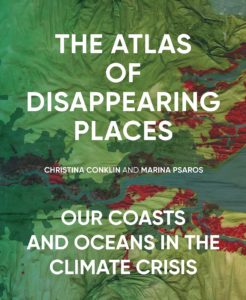For nearly an entire week earlier this month, the global climate crisis managed to grab hold of headlines. The United Nations Intergovernmental Panel on Climate Change (IPCC) had released its most recent report, concluding that human activities had warmed the planet to the edge of extinction. But stories of the spread of the Delta variant and the fall of Afghanistan’s government quickly took precedence, shifting attention away from impending climate catastrophe. Concrete remedial steps were hard to find. “As the world fried and boiled,” New Yorker environmental reporter Elizabeth Kolbert snarked, “Washington continued to do what it does best, which is argue.”

Artist Christina Conklin and activist Marina Psaros are undeterred. “Even when leadership lags,” they write in The Atlas of Disappearing Places: Our Coasts and Oceans in the Climate Crisis, “all our actions matter.” Outer Capers who cling to this beloved spit of sand jutting into the Atlantic will appreciate the Bay Area duo’s refreshing book, released last month by the New Press, which combines hard science, extensive data mapping, and ingenious utopian thinking.
While The Atlas of Disappearing Places would work well as a textbook, it is also a treat for anyone up for a systematic exploration of climate change’s effects on coastal communities around the world. Conklin and Psaros have divided the book into four sections: Changing Chemistry, Strengthening Storms, Warming Waters, and Rising Seas. They concisely explain how and where humans have gone wrong, from creating islands of plastic in the sea to situating low-income neighborhoods near oft-deluged petrochemical plants.
In each section, the authors examine five geographic locations, for a total of 20. They show that they know these places intimately, with maps, graphs, and insights. Conklin and Psaros include first- and developing-world sites affected by warming temperatures and acidifying waters, among them Camden, Maine; Kutupalong Refugee Camp, Bangladesh; Kisite, Kenya; and the Thames Estuary in Britain.

Conklin and Psaros introduce and define a key concept in each chapter. The concepts may seem obvious at first, but as Conklin and Psaros drill down, they help readers appreciate the climate-specific aspects of terms like threshold, retreat, and commons. Because of the inclusion of such terms and definitions, The Atlas of Disappearing Places may lend itself to classroom quizzes or tests. General readers will come away with a new, nuanced appreciation of such words, connecting them to pathbreaking philosophers, economists, educators, and ecologists.
My favorite section in each chapter is “A View From 2050,” focused on the future. Conklin and Psaros refuse to limit their imagined future to the most terrible possible outcomes. They explore the ways that global crises bring about “an unprecedented flow of ideas and creativity.” They predict that in 2025, for example, “alphas,” the children of millennials, might use home test kits to determine blood levels of poly- and perfluoroalkyl substances (PFAS), then have those numbers tattooed onto their fingers or shaved into their hair. By 2050, their children — a diverse bunch of “deltas” — might earn degrees online, telecommute, and vacation close to home, reducing overall carbon loads.

Or, take the Arabian Sea, currently choked by algal blooms. In 2050, Sultan Haitham bin Tariq of Oman would hammer out a regional agreement increasing renewable energy production, improving agricultural practices, enforcing stricter fish-catch limits, and encouraging offshore kelp farming to reforest the sea. Such flights of fancy, peopled with real characters, help readers appreciate the ways collaboration and imagination can bring about a better future.
The only disappointing aspect of The Atlas of Disappearing Places relates to Conklin’s artwork. Her medium for the project is an “ink-on-dried-seaweed process.” Given the book’s preoccupation with oceans, the concept is intriguing. The works might be striking when viewed in person and make for a terrific gallery show. But the translation from creation to reproduction has robbed the pieces of texture and scale. Conklin’s depiction of the city of Hamburg, Germany, for instance, is almost impossible to decipher. The superimposed white lettering is hard to read, and Conklin’s gradations between orange and red, corresponding to projected flood levels, are undiscernible. Other illustrations, maps, and more traditional graphs and tables (none involving seaweed) are clear and helpful.

Psaros, a self-described “sustainability expert,” co-founded the King Tides Project. With chapters in California, Oregon, Washington, and British Columbia, King Tides is an international nonprofit with a mission “to help people in coastal areas all over the world understand how climate change will impact their lives.” Psaros encourages planners, surfers, photographers, landscape architects, teachers, insurers, environmentalists, and others to help document sea level rise.
Perhaps interested citizen scientists of all ages will band together this fall to start an Outer Cape chapter of the King Tides Project. “We must start before we feel ready,” writes Conklin in the book’s conclusion, “and keep going even when we are tired.”
